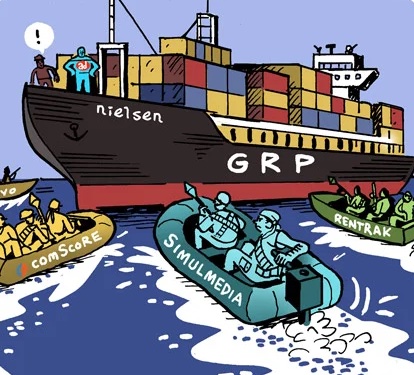Were we wrong about the future of Nielsen alternatives for TV ad currency?
Nielsen temporarily losing its accreditation from the Media Rating Council (MRC) in 2021 created a massive opportunity for the incumbent’s competitors. Ever since Nielsen was dinged for undercounting TV viewers during the pandemic, these competitors have been fighting to convince buyers and sellers alike to adopt alternatives.
And yet some industry insiders argue that alt currencies weren’t ever meant to supplant Nielsen. (Which may be news to the companies trying to poach its clients.)
Earlier this week, for example, media vet Edward Papazian wrote on LinkedIn that, unlike Nielsen, alternative currencies were “never intended as a standard to be used by all buyers and sellers” for every TV ad transaction.
“They are being used – selectively – by some sellers as add-on metrics, in addition to the standard Nielsen ratings,” continued Papazian, who’s the president of Media Dynamics, Inc., a publisher/consultancy he founded in 1982.
His comment was in response to a LinkedIn post sharing AdExchanger’s recent coverage of iSpot earning certification as a national currency from the broadcaster- and agency-backed joint industry committee.
Nielsen reigns supreme
But wait, haven’t programmers been loudly calling for independence from Nielsen’s measurement monopoly for years?
They have, but alt currencies just don’t appear to be taking off yet.
And Papazian is not the only industry leader making this point.
Most publishers and agencies have been sticking with Nielsen panels, including during the upfront negotiations this summer, because Nielsen is familiar. Nielsen’s panel data has been backing TV ad transactions for decades.
Buyers also aren’t confident enough in the ability of other video currencies to adequately compare linear and streaming viewership. One major reason is that the digital walled gardens that capture so much viewing time – YouTube, Prime Video and Netflix – don’t share viewership data.
Plus, as Papazian notes in his comment, Nielsen is incorporating new data sets incrementally so as to stay competitive against its rivals. Nielsen’s measurement product combines panel data with the viewing data it gets from TV publishers and distributors, such as Comcast, Roku and Vizio, he writes. This combined currency offering is part of Nielsen ONE, a new cross-platform product that goes beyond antiquated panels.
Starting next month, the combined offering will be Nielsen’s recommended currency, rather than the panel-only offering, as per an update in April. (The combined offering is already in market, but Nielsen’s endorsed currency is currently panel-only.)
And as for all the reported conflict between buyers and sellers over currency, “there is no struggle,” Papazian writes. “It’s all been decided.”
Papazian’s comment contradicts the scores of AdExchanger headlines heralding the impending adoption of alt currencies. But his point may better reflect the reality – that Nielsen will always have a foundational role to play in TV ad buying.
Guess it’s good to be a ratings titan.
The future of alt currencies
That isn’t to say that other video currencies face obsolescence.
Newer currencies have earned reputations for specialties that panel data alone can’t accomplish. Comscore boasts strength in local, for example, while VideoAmp has advanced audiences and iSpot touts cross-screen attribution and demos.
This is why buyers and sellers are selectively using alt currencies as add-ons to Nielsen.
Video currencies with different data and methodologies produce different numbers. That variance explains why buyers and sellers can – and do – transact with several currencies simultaneously to compare the results and zero in on the measurement provider that feels most aligned with specific campaign goals or KPIs. Buyers have reason to spend more money on currencies that seem to generate the best results.
For example, if a buyer compares VideoAmp and Nielsen reports for similar campaigns and sees higher impression counts for advanced audiences from VideoAmp, that buyer may choose to spend a higher proportion of their media budget using VideoAmp.
But Nielsen isn’t going anywhere.
In other words, at least for now, alt currencies will likely remain as add-ons to support specific campaign goals.
What I’m wondering is: Will alt currencies ever become a standard, or are they doomed to remain TV measurement sidekicks?
Let me know what you think. Hit me up at [email protected].

















